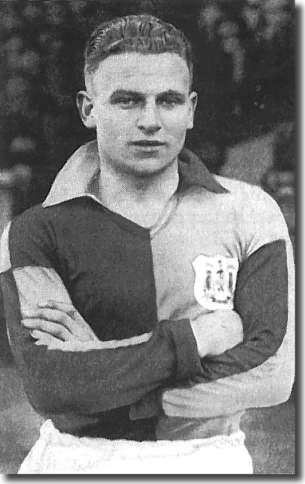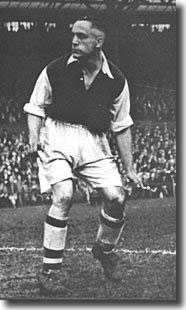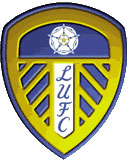|
 Just
as mighty Arsenal had descended on Elland Road in the summer of 1934 to
steal away a major talent (Wilf Copping), so their North London neighbours
Tottenham Hotspur did in June 1938. Spurs came a-calling for Leeds' England
right-back, Bert Sproston, and £9,500 was enough to persuade the Elland
Road board to part with one of its prize assets. The record fee at that
time was still the £10,890 that Arsenal had spent a decade earlier to
buy inside-forward David Jack from Bolton and the money on offer was all
too readily grabbed by a club that was still financially struggling. Two
months later, Arsenal broke the transfer record again by signing Bryn
Jones from Wolves for £14,000. Just
as mighty Arsenal had descended on Elland Road in the summer of 1934 to
steal away a major talent (Wilf Copping), so their North London neighbours
Tottenham Hotspur did in June 1938. Spurs came a-calling for Leeds' England
right-back, Bert Sproston, and £9,500 was enough to persuade the Elland
Road board to part with one of its prize assets. The record fee at that
time was still the £10,890 that Arsenal had spent a decade earlier to
buy inside-forward David Jack from Bolton and the money on offer was all
too readily grabbed by a club that was still financially struggling. Two
months later, Arsenal broke the transfer record again by signing Bryn
Jones from Wolves for £14,000.
A few weeks earlier, Leeds had also released centre-forward Arthur Hydes
to Newport County; Hydes had missed the whole of the previous season and
he had suffered significant injury problems throughout his period at Elland
Road, although his return of 74 goals in 127 league games was notable.
South African centre-forward Gordon Hodgson was still going strong and,
despite being 34 years old, showed no signs of wanting to retire, so Hydes
upped sticks for Wales.
Leeds drafted 22-year-old Ken Gadsby in to replace Sproston. The full-back
had joined the club in October 1934 from Wilf Copping's first club, Middlecliffe
Rovers, but had only played once so far for the first-team. The rest of
the side was much as it had been the previous season, although the return
of 35-year-old Willis Edwards, now
a veteran of almost 400 league games, lifted the average age of a youthful
outfit.
David Cochrane on the right and Jack Hargreaves at outside-left had youth,
pace and potential, but the forwards, save for Hodgson, often toiled vainly
for goals.
They had started strongly in previous years and did so again. Indeed,
they won 9 of the first 15 matches and the visit of Leicester to Elland
Road on 1 October saw Hodgson run riot, scoring five times in an 8-2 win.
Two games later on 15 October, Willis Edwards made his 400th appearance
in a 1-0 home win over Wolves. However, following Hodgson's 13th goal
of the season, in a 2-1 win at Blackpool on 19 November, there was a distinct
change of fortunes. At that point Leeds were outdoing themselves in third
place.
United went through an appalling spell of form, winning just once in
15 games and descending at a rate of knots down the table. An FA Cup third
round win at Elland Road against Bournemouth and a 2-1 home defeat of
Charlton were the only successes. Huddersfield Town, now only a shadow
of the glorious club of the Twenties, were the opposition in the fourth
round. Town had only picked up two draws on their travels in the league
and had already lost to Leeds on their own turf, so they looked easy meat.
Leeds were 2-0 up by half-time with goals from Hodgson and David Cochrane
and looked to be coasting. The first 25 minutes of the second half overturned
all the good work, however. Huddersfield centre-forward Bill Price hit
a hat trick as the Terriers won 4-2 at Elland Road to leave United with
nothing to play for but their pride. They were well clear of relegation
(although if their slide had continued they would have been drawn into
a battle), but were equally distant from a tilt at the title.
They ended their depressing sequence and showed what they were still
capable of by beating champions Arsenal 4-2 at Elland Road on 11 March
with Eric Stephenson (with a penalty), Aubrey Powell, Hodgson and Jack
Hargreaves scoring the goals. Arsenal were about to surrender their title
to Everton, but were still a class outfit, and the triumph was particularly
satisfying as it enabled Leeds to complete the double over the Gunners,
having won 3-2 at Highbury at the beginning of November, with two goals
from Stephenson and another from Arthur Buckley.
Notably, the Elland Road victory over Arsenal was the second game back
in Leeds colours for Wilf Copping.
He had returned from a five-year stay at Highbury and he obviously relished
the thrill of putting one over his former club, although he had only left
them to return to Yorkshire as the threat of war hung heavy on the air.
The return of Copping signalled a mini-revival in United's fortunes. Around
the same time Leeds splashed out £3,750 to buy centre-forward Len Dunderdale
from Watford. Dunderdale played three matches as cover for the injured
Hodgson, but didn't get on the scoresheet. In fact, the goals had more
or less dried up for Leeds after Christmas and their attack looked distinctly
jaded.
With Copping rallying the troops, there was more bite about the team
and in the left-half's 12 matches at the end of the season they conceded
just 9 goals. Four of those came in one match against Birmingham, whose
easy win couldn't stave off relegation for them. Clearly, the England
hard man had made a significant difference, although the imminent threat
of war prevented there being too much optimism. The late improvement in
form helped Leeds finish in a comfortable mid-table position, nine points
below third, but also a crucial nine points clear of relegation.
Average attendances at Elland Road remained only a fraction below
20,000, despite the spectre of war and the Boxing Day defeat against
Derby County drew more than 34,000.
If the war had not intervened at that point, Leeds United may
have gone on to bigger and better things: they had a good young
team that was capable of brilliance on its day and would surely
have got better. Copping, at 29, may have been past his very best
but could have brought out the best in the youngsters, but sadly,
it was not to be; there were to be  six
long and dark years of battle and seven lost seasons before official
football competition resumed. Young players like Eric Stephenson
(who lost his life during the war), Jim Twomey, Jim Makinson,
George Ainsley and Arthur Buckley saw their best playing years
ripped away from them by the European conflict and were never
the same after the resumption of official football competition
in 1946. six
long and dark years of battle and seven lost seasons before official
football competition resumed. Young players like Eric Stephenson
(who lost his life during the war), Jim Twomey, Jim Makinson,
George Ainsley and Arthur Buckley saw their best playing years
ripped away from them by the European conflict and were never
the same after the resumption of official football competition
in 1946.
Other Football Highlights from 1938/39
- Arsenal needed a replacement for Alex James, who had recently retired,
and manager George Allison was convinced that Bryn Jones was the man
he wanted. So, at the start of the season, he broke the transfer record,
paying £14,000 in four instalments to Wolves to bring the Welsh
inside-forward to Highbury
- Wolves only conceded 39 goals in 42 matches, a First Division
record since the introduction of the revised offside law in
1925, but still finished four points behind champions Everton.
Barnsley did even better, only conceding 34 goals on their way
to the Third Division North title
- In the FA Cup final, Wolves, who had been challenging for
the championship, were 5-1 on to beat Portsmouth, who had spent
most of the season fighting to avoid relegation. However, in
front of the biggest crowd (99,730) since the White Horse final
of 1923, Wolverhampton simply froze on the day and allowed Portsmouth
to finish comfortable 4-1 winners
- England faced World Cup holders Italy in Milan on 14 May and drew
2-2. The Italians' second goal was clearly the result of a handball,
but England were satisfied with a draw in their first match against
Italy since the Battle of Highbury in 1934
- Willie Hall equalled the England scoring record when he got five goals
in the 7-0 defeat of Northern Ireland on 16 November. Despite that result,
England finished in a three way tie with Scotland and Wales in the Home
International Championships following a 4-2 defeat in Cardiff
- The match fee paid to internationals players by the FA was
raised from £6 to £10
back to top
|












 Just
as mighty Arsenal had descended on Elland Road in the summer of 1934 to
steal away a major talent (Wilf Copping), so their North London neighbours
Tottenham Hotspur did in June 1938. Spurs came a-calling for Leeds' England
right-back, Bert Sproston, and £9,500 was enough to persuade the Elland
Road board to part with one of its prize assets. The record fee at that
time was still the £10,890 that Arsenal had spent a decade earlier to
buy inside-forward David Jack from Bolton and the money on offer was all
too readily grabbed by a club that was still financially struggling. Two
months later, Arsenal broke the transfer record again by signing Bryn
Jones from Wolves for £14,000.
Just
as mighty Arsenal had descended on Elland Road in the summer of 1934 to
steal away a major talent (Wilf Copping), so their North London neighbours
Tottenham Hotspur did in June 1938. Spurs came a-calling for Leeds' England
right-back, Bert Sproston, and £9,500 was enough to persuade the Elland
Road board to part with one of its prize assets. The record fee at that
time was still the £10,890 that Arsenal had spent a decade earlier to
buy inside-forward David Jack from Bolton and the money on offer was all
too readily grabbed by a club that was still financially struggling. Two
months later, Arsenal broke the transfer record again by signing Bryn
Jones from Wolves for £14,000. six
long and dark years of battle and seven lost seasons before official
football competition resumed. Young players like Eric Stephenson
(who lost his life during the war), Jim Twomey, Jim Makinson,
George Ainsley and Arthur Buckley saw their best playing years
ripped away from them by the European conflict and were never
the same after the resumption of official football competition
in 1946.
six
long and dark years of battle and seven lost seasons before official
football competition resumed. Young players like Eric Stephenson
(who lost his life during the war), Jim Twomey, Jim Makinson,
George Ainsley and Arthur Buckley saw their best playing years
ripped away from them by the European conflict and were never
the same after the resumption of official football competition
in 1946.